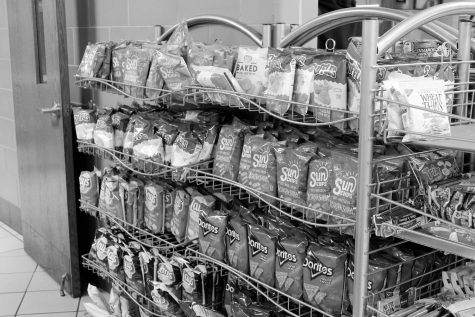Junk foods spur withdrawal effects

No burgers or chips. No cake or donuts. No cookies or candy. These restrictions were part of the food challenge seniors Gabi Ocasek and Ben Holub undertook at the start of the school year after seeing the idea on an Instagram post. They decided to follow it in an attempt to eat healthier for 30 days.
“It almost felt like withdrawal when I wasn’t able to eat [the foods banned by the challenge],” said Ocasek. “I craved [them], and I wanted sugar.”
A recent study conducted by researchers at University of Michigan, Ann Arbor, found that eliminating junk food from a person’s diet can cause withdrawal-like symptoms, such as intense irritability, headaches, cravings, lethargy and nausea. Though not as intense, these symptoms are similar to cigarette or marijuana withdrawals. The effects occur when one eats foods high on the glycemic index, such as cake or french fries, that stimulate the pleasure center in the brain. When junk food is removed from the diet, the pleasure center is stimulated less frequently from sugar. This causes the body to crave sugar to reactivate the center, which results in withdrawal symptoms lasting two to five days. The study’s results were collected via a self-reported measure called the Highly Processed Food Withdrawal Scale, also known as ProWS.
Erica Schulte, doctoral candidate in clinical psychology at the University of Michigan, Ann Arbor, said in an email exchange that she was involved in conducting research for and writing the study. She also adopted the ProWS system by reviewing self-reported symptoms of nicotine and cannabis withdrawal which she then applied to measure how people were struggling to remove junk food from their diets or had struggled to do so in the past. Using ProWS, Schulte measured physical symptoms, such as headaches, and psychological symptoms, such as irritability.
Licensed dietitian nutritionist Bonnie C. Minsky said in an email exchange that people between the ages of two and 18 should be consuming at most 25 grams of refined sugar in their diet per day. But on average, Americans in this age range typically consume 82 grams daily.
Ocasek said the hardest part of the challenge for her was the intense cravings.
“Ever since the first day, I wanted a milkshake really bad, so on the day [our challenge] ended, I went to Potbelly,” said Ocasek. “I got Ben a milkshake. I got a milkshake and a cookie. … It [felt like] the best day of my life.”
Once she reintroduced foods banned by the challenge into her diet, Ocasek said she felt stomach pains and general discomfort for a few days.
Minsky said sugar withdrawal can occur when consuming 25 grams of sugar or less per day, but the amount can vary depending on a person’s sensitivity to sugar or family history of diabetes.
Schulte said while withdrawal symptoms usually peak between two and five days after a diet change, the symptom intensity is dependent on how much junk food was originally in a person’s diet. The intensity also increases if a large amount of junk food is consumed. This causes an addictive-like relationship with food.
Minsky said for someone going through withdrawal, eating protein at every meal, such as eggs, fish or chicken, exercising every day and taking a magnesium supplement will help alleviate the symptoms.
Ocasek said she believes anyone could have a healthier diet, even if they don’t follow the challenge directly.
“I know it’s hard to suddenly cut out all [of the unhealthy foods], but I think people can do it if they are actually determined,” said Ocasek. “If they have a motivation … they can [be healthier].”

